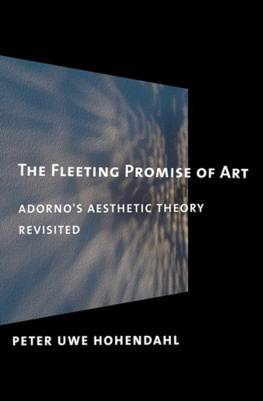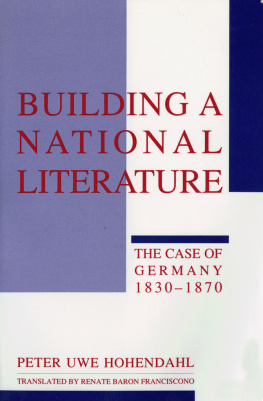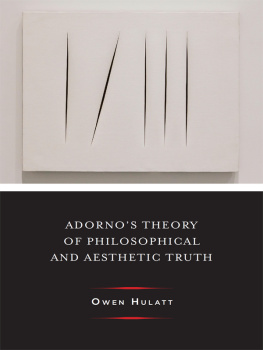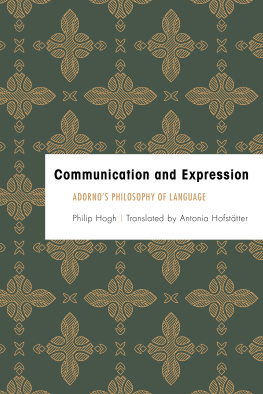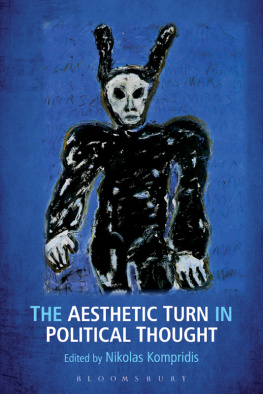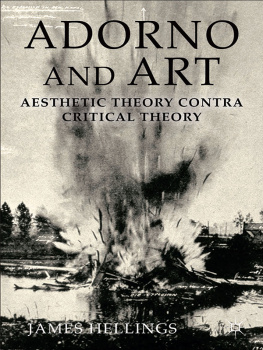Hohendahl - The Fleeting Promise of Art: Adornos Aesthetic Theory Revisited
Here you can read online Hohendahl - The Fleeting Promise of Art: Adornos Aesthetic Theory Revisited full text of the book (entire story) in english for free. Download pdf and epub, get meaning, cover and reviews about this ebook. City: Cornell University Press, publisher: Cornell University Press, genre: Romance novel. Description of the work, (preface) as well as reviews are available. Best literature library LitArk.com created for fans of good reading and offers a wide selection of genres:
Romance novel
Science fiction
Adventure
Detective
Science
History
Home and family
Prose
Art
Politics
Computer
Non-fiction
Religion
Business
Children
Humor
Choose a favorite category and find really read worthwhile books. Enjoy immersion in the world of imagination, feel the emotions of the characters or learn something new for yourself, make an fascinating discovery.
- Book:The Fleeting Promise of Art: Adornos Aesthetic Theory Revisited
- Author:
- Publisher:Cornell University Press
- Genre:
- City:Cornell University Press
- Rating:3 / 5
- Favourites:Add to favourites
- Your mark:
- 60
- 1
- 2
- 3
- 4
- 5
The Fleeting Promise of Art: Adornos Aesthetic Theory Revisited: summary, description and annotation
We offer to read an annotation, description, summary or preface (depends on what the author of the book "The Fleeting Promise of Art: Adornos Aesthetic Theory Revisited" wrote himself). If you haven't found the necessary information about the book — write in the comments, we will try to find it.
Hohendahl: author's other books
Who wrote The Fleeting Promise of Art: Adornos Aesthetic Theory Revisited? Find out the surname, the name of the author of the book and a list of all author's works by series.
The Fleeting Promise of Art: Adornos Aesthetic Theory Revisited — read online for free the complete book (whole text) full work
Below is the text of the book, divided by pages. System saving the place of the last page read, allows you to conveniently read the book "The Fleeting Promise of Art: Adornos Aesthetic Theory Revisited" online for free, without having to search again every time where you left off. Put a bookmark, and you can go to the page where you finished reading at any time.
Font size:
Interval:
Bookmark:
THE AUTONOMY OF ART
If Adorno had died in 1949 instead of 1969, he would be remembered today primarily as the coauthor, with Max Horkheimer, of Dialectic of Enlightenment . That is, he would be remembered as a fierce critic of the European Enlightenment including Immanuel Kant. What Adorno and Horkheimer had to say about Kant in this pathbreaking study was mostly negative and hostile. Kant makes an appearance in the second chapter, along with the Marquis de Sade, where the authors want to demonstrate that the sage of Knigsberg is very much part of a trajectory that began in the seventeenth century and ultimately resulted in the triumph of fascism in Europe. The dialectic of the Enlightenment consists precisely of the intimate but obscured connection between rationalism and fascism. In the development of modern philosophy from Bacon to Carnap, Kant is part of the transformation of reason into positivist rationality, which is the other side of the same coin better known as the mythic irrationalism of fascism. In a more conventional historical reconstruction (for instance that of Ernst Cassirer) Kant would have been evoked as the rationalist opponent of this irrationalism, as the defender of humanism and progress. Instead, Adorno and Horkheimer saw Kant as part of the very reduction of reason that prepared the way for the ultimate historical catastrophe.
Some of the same ideas recur in Adornos later writings. There are occasional moments when Adorno emphasizes his distance from Kant, a certain impatience with Kants Brgerlichkeit and lack of radical philosophical reflection, but for the most part Adornos assessment of Kant is much more positive in his postwar writings. This remarkable return to Kant is by no means limited to a specific field of philosophy. Rather, Adornos renewed engagement with Kant is equally concerned with his epistemology, his moral philosophy, and his aesthetic theory, which will be at the center of my analysis. It is important to grasp the broad spectrum of Adornos rereading of Kant as well as the interconnectedness of his attempts to revive the interest in Kant in various fields of philosophy.
My intention here is not to dwell on the reasons for Adornos surprising return to Kant. The new engagement was probably related, at least in part, to his teaching obligations at the University of Frankfurt. He was expected to offer lecture courses and seminars that would cover the German philosophical tradition. For instance, he offered one lecture course in 1959 on Kants Critique of Pure Reason and another one in 1963 entitled Problems in Moral Philosophy, which focused largely on Kant. To a lesser degree his lectures on metaphysics (1965) and on aesthetics (1958/59) dealt with Kants thought as eminently relevant for the present. If a critical reassessment of the German intellectual tradition was at the center of Adornos postwar pedagogy in Frankfurt, Kant clearly occupied a prominent place, rivaled only by Hegel, who also received Adornos renewed attentions. The full extent of his engagement with Kant became visible only more recently when his posthumous writings, including his lectures, were published.
Although Adornos rereadings by no means signaled a dogmatic return to a Kantian framework, even a cursory review of these writings betrays a significant change in Adornos thinking, one that occurred after his return to Germany in 1950. Now Kant appears as a central figure with power to restore confidence in the German tradition. At the very least, Adorno considered it vital to inform a new generation of students of the philosophical importance of Kant. But theres more to it than that. It is clear that Adorno did not mean to return to the neo-Kantians of the early twentieth century. While they are sometimes mentioned (among them his own teacher Hans Cornelius), their positions are not validated. As we will see, it becomes important for Adorno to reframe the approach to Kant by marking his distance from the neo-Kantians. This effort is particularly strong in his lectures on Kants First Critique, where he has to navigate carefully between the latent positivism of a neo-Kantian reading and a radical metaphysical reading of Heidegger that is closer to (but not identical with) his own efforts. Precisely for this reason the distance from Heidegger has to be underlined.
Adornos lectures on Kants Critique of Pure Reason in particular demonstrate his intent to explore aspects of Kantian thought that the neo-Kantians had neglected or pushed into the background as no longer relevant. Again and again, Adorno explains to his audience that he is not interested in a dogmatic introduction or a pure reconstruction of Kants epistemological position. His discussion of Kants epistemology is intended to recover the foundations of Kants thought, foundations that would be equally relevant for a sustained discussion of ethics and aesthetics. For Adorno, the essential Kant is articulated in the First Critique. When it comes to aesthetic theory, Kants Critique of Judgment is recognized as an important text, but ultimately not as important as Hegels aesthetics. In other words, for Adornos own aesthetic theory the insights of Kants First Critique turn out to be more valuable and demanding than Kants discussion of the artwork. In the final analysis, Adorno fundamentally disagrees with Kants approach to art, which means that he can make only selective use of Kants Third Critique.
For the reasons mentioned above, any discussion of Adornos postwar reading of Kant has to begin with the Critique of Pure Reason . In this chapter, however, I will restrict myself to a reconstruction of Adornos approach and a discussion of the central themes. It should be noted at the outset that Adorno is much less interested in Kants solutions than Kants questions and the internal contradictions that are the result of addressing these questions. Put differently, he means to examine Kants response to the problems he inherited from his predecessors (i.e. the German metaphysical tradition and the radical skepticism of Hume) as options that determined the later history of philosophy. By later history of philosophy Adorno means the idealism of Fichte, Schelling, and Hegel on the one hand, and the positivism of scientific philosophy on the other (which, by the way, means that he implicitly acknowledges twentieth-century logical positivists as legitimate heirs of Kant). The tension between these contradicting positions is, as Adorno insists, the enigma of Kant, the reason why we have to return to his texts. His rereading of the First Critique especially explores the metacritical level, because a reading at this level enables the reader to understand the structure of Kants thought rather than the mere truth and legitimacy of certain positions. For this reason Adorno proceeds selectively and is highly unorthodox in his own emphasis.
Adorno is aware that even among his students familiarity with Kant cannot be taken for granted after the Third Reich. Therefore, one important task of his lectures was to lay the ground for a critical reception of Kants epistemology, but he also understood that such grounding must avoid continuing the neo-Kantian interpretation of Kant. Adorno describes the task in the following manner: So what I would like to do is to retranslate this philosophy from a codified, ossified system back into the kind of picture that results from a sustained X-ray examination, and he continues by insisting that Kant should be understood as a force field ( Kraftfel d ) where the careful reader finds extraordinary forces of experience ( Erfahrung ) behind the abstract concepts. By emphasizing the concept of experience Adorno prepares a double move: he breaks up the conventional history of philosophy, which is constructed along the lines of concepts and ideas, and he creates a stronger link between philosophy and related cultural experiences and institutionsfor instance, music or literature. Thus Adorno is not simply attempting to restore the lost authority of Kants First Critique; he means to explicate the problems Kant faced at the level of concrete historical experiences.
Font size:
Interval:
Bookmark:
Similar books «The Fleeting Promise of Art: Adornos Aesthetic Theory Revisited»
Look at similar books to The Fleeting Promise of Art: Adornos Aesthetic Theory Revisited. We have selected literature similar in name and meaning in the hope of providing readers with more options to find new, interesting, not yet read works.
Discussion, reviews of the book The Fleeting Promise of Art: Adornos Aesthetic Theory Revisited and just readers' own opinions. Leave your comments, write what you think about the work, its meaning or the main characters. Specify what exactly you liked and what you didn't like, and why you think so.

